
The solar-powered buoy sends alerts to lifeguards within seconds of detecting a tagged great white shark
A break in the morning rain proved all a team of marine researchers from the University of New England needed to brave the choppy waters of Saco Bay to deploy a real-time shark detection buoy for the second time.
As storm clouds dissipated, a group of students from the UNE’s School of Marine and Environmental programs, led by John Mohan, Ph.D., assistant professor, in partnership with a marine scientist from the Maine Department of Marine Resources (DMR), traveled from UNE’s research pier to a location not far from the coastal hamlet of Ocean Park, mere miles from campus, to drop the buoy in place.
The buoy, purchased with funding from the Maine Outdoor Heritage Fund, is linked to a broader network of several other archival detection buoys in Maine and Massachusetts. With the aid of solar panels and telemetry equipment, the buoy can send a signal in real time to lifeguards and users of the Sharktivity mobile app if a tagged white shark passes within 500 meters of the device’s location.
The goal of the project, Mohan said, is to help the state of Maine more broadly monitor shark populations and their movements while also promoting education and public safety.
“White sharks have always been in Maine waters, but this collaborative research effort aims to better understand their seasonal movements using acoustic tagging technology,” Mohan explained.
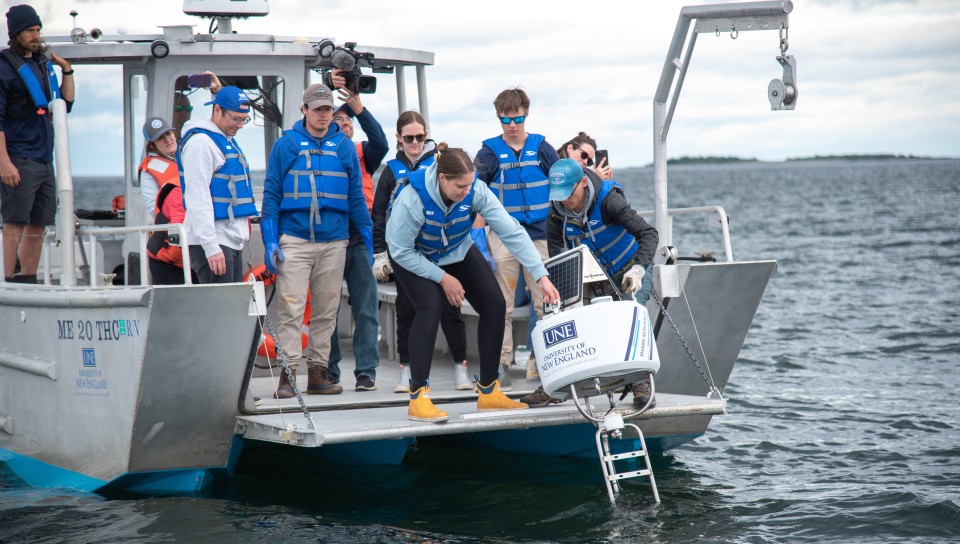
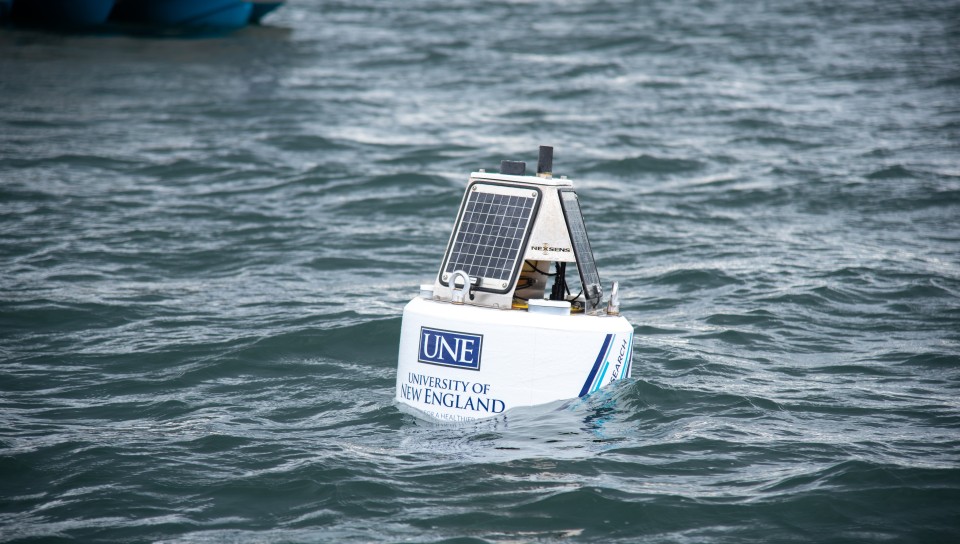
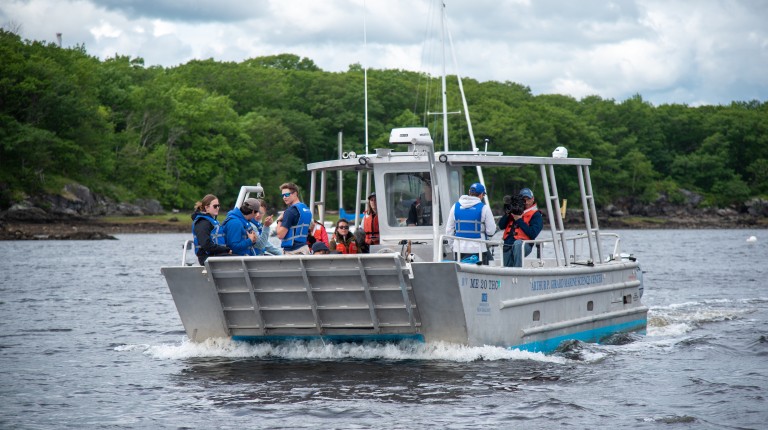
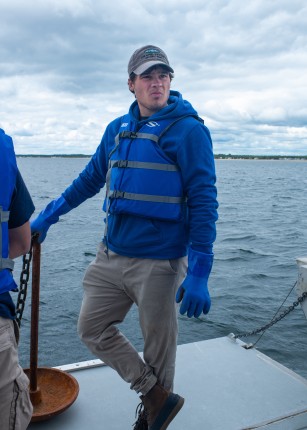
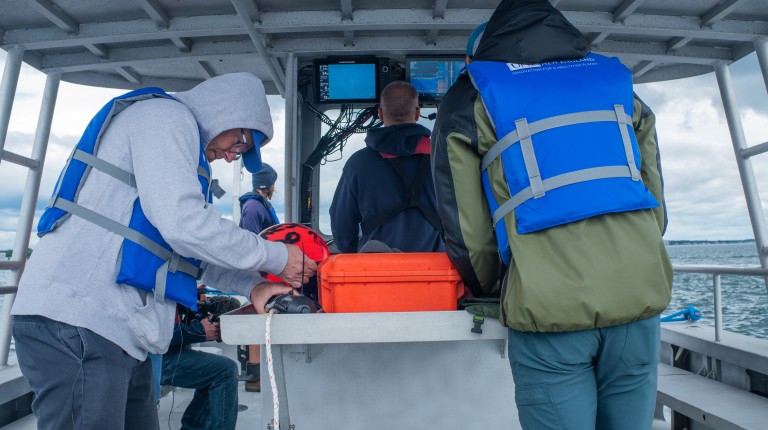
This is the second year Mohan, his students, and the DMR piloted into Saco Bay to deploy the buoy, though this year’s iteration saw a new paint job and upgrades in technology.
The same device was floated last year in a nearby spot, where it was able to detect one tagged white shark as it made its way north from Cape Cod. This year, it was placed in slightly deeper waters, in hopes that the research team can identify more sharks once they make their summer journey to Maine’s waters, where they can be found feeding on seals, the population of which has rebounded in recent years.
“We hope the ongoing monitoring efforts will help us better understand Maine white shark behavior and keep the public aware and interested in these marine predators,” Mohan said.
The state began monitoring the movements of white sharks after a woman was killed by a shark off of Harpswell in an extremely rare attack in 2020. In 2022, the state logged over 1,000 detections from tagged great white sharks, and there were 44 confirmed great white sightings.
Working with Maine DMR, Massachusetts Marine Fisheries, and Atlantic White Shark Conservancy, UNE hopes to track more sharks this year as they move up and down Maine’s rocky coast, sending real-time alerts to lifeguards to ensure the safety of summer beachgoers.
Watch: UNE Deploys Shark Detection Buoy
Watch UNE student and faculty researchers deploy a real-time shark detection buoy into the waters just off UNE’s coastal campus. The device, powered by the sun and fitted with telemetry equipment, sends an alert to lifeguards within seconds of detecting a tagged great white shark, keeping Maine’s beachgoers safe.
“Studying the way that sharks interact with their environment throughout the seasons is so crucial to not only protecting them but keeping the public safe,” said Emma Christopher (Marine Biology, ’25). “Coastal Maine is very popular for tourists and vacationers, so it is important that we keep ourselves and the sharks safe.”
The state’s ramped-up efforts to study sharks have proven to be a boon for UNE’s marine science students looking to engage themselves in research.
“I have been obsessed with sharks my entire life and have been photographing them while SCUBA diving since I was nine years old,” remarked Clayton Nyiri (Marine Sciences, ’25), who helped deploy the latest buoy. “Engaging myself in this research not only allows me to grow as a scientist and a person but also inform the public about how the animals I love are not to be feared, but respected.”
As a marine researcher, Nyiri said, he wants to track sharks and learn more about their ecological movements. To have this experience as an undergraduate student, he said, will prime him for his future career.
“This is an unbelievable opportunity that allows me to get all the experience I need to go further in life, and it drives me more and more each day to study these animals,” he stated.
View Press Coverage
- Boat launches, sharks, and working waterfronts (Maine Boats)
- Researchers renew efforts to track shark white activity off Maine coast (Yahoo!)
- Researchers from UNE launch shark buoy (NEWS CENTER Maine)
- UNE students help detect sharks in Saco Bay (WGME CBS 13)
- UNE students help detect sharks in Saco Bay (Fox 23 Maine)
- UNE students deploy shark detection buoy in Saco Bay (WMTW NEWS 8)
- With Maine's growing interest in sharks, students deploy a buoy that can track them in real time (Maine Public)
- With Maine's growing interest in sharks, students deploy a buoy that can track them in real time (Our Community Now)